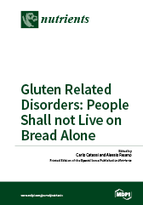Gluten Related Disorders: People Shall not Live on Bread Alone
A special issue of Nutrients (ISSN 2072-6643).
Deadline for manuscript submissions: closed (31 May 2015) | Viewed by 304418
Special Issue Editors
2. Italian Society for Pediatric Gastroenterology, Hepatology and Nutrition (SIGENP), Milan, Italy
Interests: celiac disease; gluten-related disorders; gluten sensitivity; pediatric gastroenterology; pediatric nutrition
Special Issues, Collections and Topics in MDPI journals
Special Issues, Collections and Topics in MDPI journals
Special Issue Information
Dear Colleagues,
Once upon a time, gluten was not a part of the human diet, and therefore, there were no gluten-related disorders. With the advent of agriculture 10,000 years ago, the introduction of gluten-containing grains in the human diet created conditions for human diseases related to gluten exposure. These diseases, including celiac disease, non-celiac gluten sensitivity, and wheat allergy, have distinct pathophysiological mechanisms, serological markers, and long-term treatments, but similar, often overlapping clinical presentations. Though current research strives to clarify the boundaries between these entities, their differences can be difficult to distinguish.
For a very long time, awareness of these disorders has been limited and, therefore, the epidemiology of gluten-related disorders has been a “work in progress”. New epidemiological studies have revealed that gluten-related disorders are not limited to European regions; rather, they are present worldwide.
After centuries of neglected attention to celiac disease and other forms of gluten reaction, now we are observing another interesting phenomenon that is generating great confusion among health care professionals. Nearly 25% of Americans (many more than the projected 3 million CD patients in the U.S.) are reducing or cutting gluten from their diets. This remarkable trend in the general population reflects the misconception that gluten can be harmful for everybody and, therefore, should be avoided to stay healthy, to lose weight, or even to prevent severe diseases.
This Special Issue of Nutrients will contain contributions from leading experts in the field of gluten-related disorders that will help dissipate this confusion by sharing their evidence-based science, which will help the reader to distinguish facts from fantasies.
Prof. Carlo Catassi
Prof. Alessio Fasano
Guest Editors
Manuscript Submission Information
Manuscripts should be submitted online at www.mdpi.com by registering and logging in to this website. Once you are registered, click here to go to the submission form. Manuscripts can be submitted until the deadline. All submissions that pass pre-check are peer-reviewed. Accepted papers will be published continuously in the journal (as soon as accepted) and will be listed together on the special issue website. Research articles, review articles as well as short communications are invited. For planned papers, a title and short abstract (about 100 words) can be sent to the Editorial Office for announcement on this website.
Submitted manuscripts should not have been published previously, nor be under consideration for publication elsewhere (except conference proceedings papers). All manuscripts are thoroughly refereed through a single-blind peer-review process. A guide for authors and other relevant information for submission of manuscripts is available on the Instructions for Authors page. Nutrients is an international peer-reviewed open access semimonthly journal published by MDPI.
Please visit the Instructions for Authors page before submitting a manuscript. The Article Processing Charge (APC) for publication in this open access journal is 2900 CHF (Swiss Francs). Submitted papers should be well formatted and use good English. Authors may use MDPI's English editing service prior to publication or during author revisions.
Keywords
- celiac disease
- autoimmunity
- food antigen trafficking
- gut permeability
- microbiome
- food sensitivities








